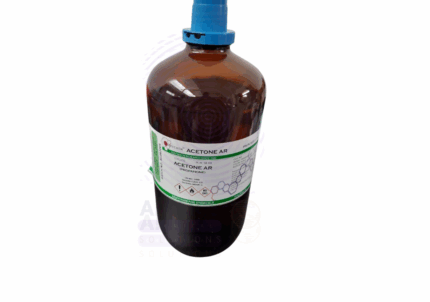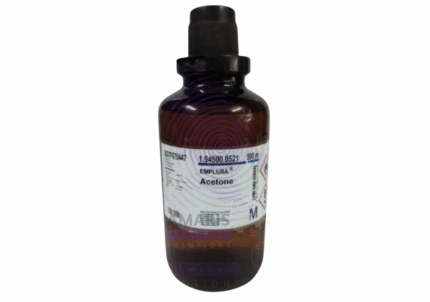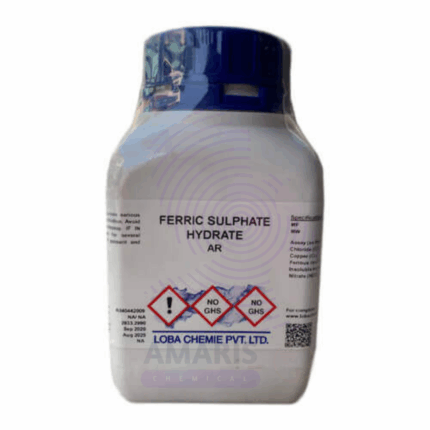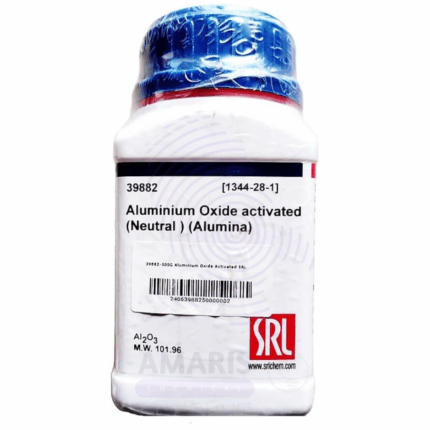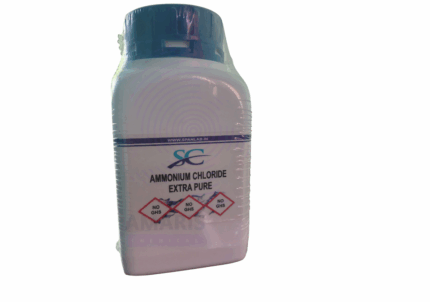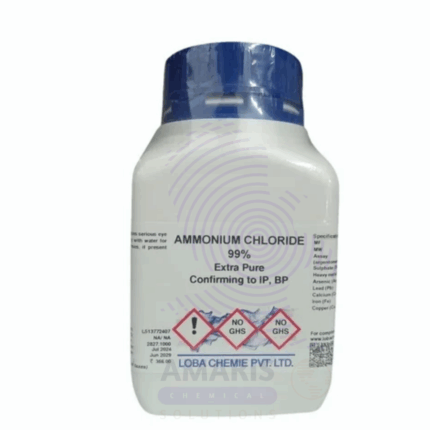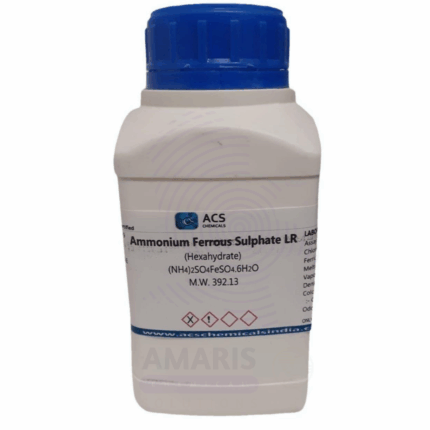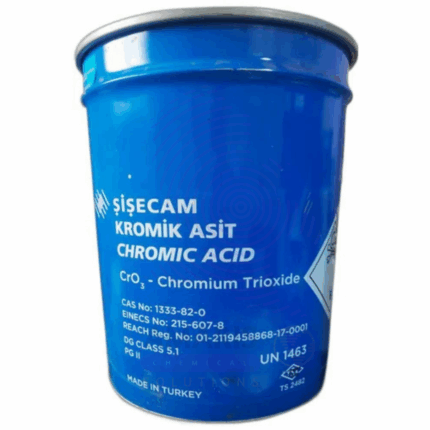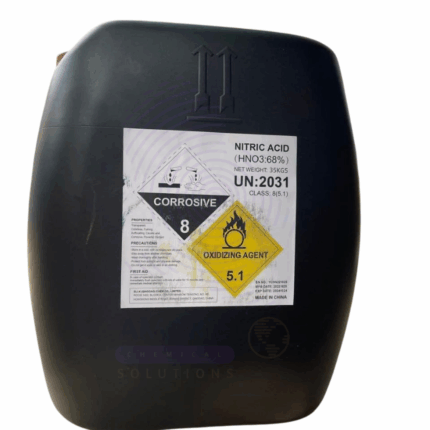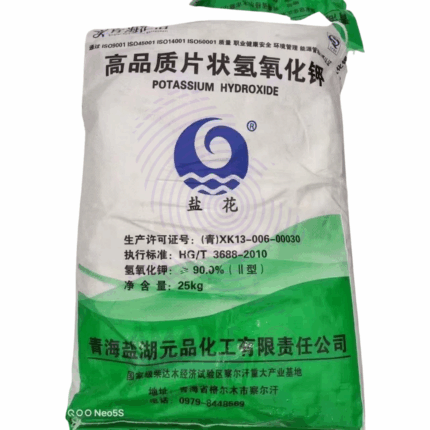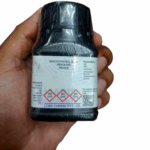
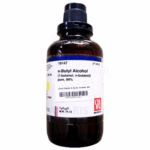
Butanoic Acid Extra Pure
$ 35.00 Original price was: $ 35.00.$ 34.78Current price is: $ 34.78.
Butanoic Acid Extra Pure, also known as butyric acid, is a high-purity carboxylic acid used in laboratory research for organic synthesis, esterification studies, and biochemical analysis. It serves as a building block in the preparation of esters, polymers, and pharmaceuticals, and is also studied for its role in metabolic and microbial pathways. With its strong, characteristic odor and reactive carboxyl group, it is valuable in reaction mechanism investigations and as a standard in acid-base titrations. The extra pure grade ensures low levels of moisture and contaminants, offering consistent performance in sensitive experiments. It should be handled in well-ventilated areas and stored in tightly sealed containers, away from heat and oxidizing agents.
Butanoic Acid Extra Pure
Primary Uses
- Organic Chemistry Reagent
- Acts as a carboxylic acid reference compound in synthesis and analysis.
- Used in esterification reactions to produce butanoate esters (e.g., ethyl butanoate), helpful in studying reaction mechanisms and yields.
- pH and Acidity Studies
- Employed in acid-base titrations and buffer system experiments to demonstrate weak acid behavior and calculate dissociation constants (Ka).
- Biochemistry & Metabolism Research
- Studied as a short-chain fatty acid (SCFA) in microbial fermentation, gut microbiome, or metabolic pathway simulations.
- Spectroscopic Characterization Practice
- Used in IR, NMR, and GC-MS labs to teach or validate spectral interpretation of carboxylic acid functional groups.
Secondary Uses
- Odor Demonstration in Sensory Science
- Sometimes used (with caution) to demonstrate volatile organic compounds (VOCs) due to its strong rancid odor—a sensory example of SCFAs.
- Preparation of Calibration Standards
- Used to create known concentration solutions for HPLC or GC method development, especially in fatty acid quantification.
- Fermentation & Microbiology Studies
- Acts as a by-product in microbial cultures—can be added or measured in fermentation simulations or SCFA profiling experiments.
| PACK SIZE |
2.5 Litres Glass bottle |
|---|
1. Basic Identification Attributes
- Chemical Name: Butanoic Acid
- CAS Number: 107-92-6
- HS Code: 2915.60.00
- Molecular Formula: C₄H₈O₂
- Molecular Weight: 88.11 g/mol
- Synonyms: Butyric acid, n-Butyric acid, n-Butanoic acid
- Grade: Extra Pure (suitable for analytical and laboratory use)
2. Physical & Chemical Properties
- Appearance: Colorless to pale yellow oily liquid
- Odor: Strong, rancid, unpleasant odor (like spoiled butter)
- Solubility:
- Miscible with ethanol, ether
- Slightly soluble in water (7.3 g/100 mL at 20 °C)
- Boiling Point: ~163.5 °C
- Melting Point: -7.9 °C
- Density: ~0.96 g/cm³ at 20 °C
- pKa: ~4.82 (weak acid)
- Vapor Pressure: 0.38 mmHg at 25 °C
3. Safety & Hazard Attributes
- GHS Classification:
- Skin Corrosion/Irritation (Category 1B)
- Serious Eye Damage (Category 1)
- GHS Pictograms:
- Hazard Statements:
- H314: Causes severe skin burns and eye damage
- Precautionary Statements:
- P280: Wear protective gloves, clothing, eye and face protection
- P305+P351+P338: IF IN EYES – rinse cautiously with water for several minutes
- NFPA Ratings:
- Health: 3
- Flammability: 1
- Reactivity: 0
4. Storage & Handling Attributes
- Storage Conditions:
- Store in a tightly closed container
- Keep in a cool, well-ventilated, and corrosive chemical-safe area
- Incompatible Materials:
- Strong bases, oxidizers, and reducing agents
- Packaging: Amber glass bottles or HDPE containers with acid-proof caps
- Handling Precautions:
- Use under a fume hood due to pungent vapors
- Wear gloves, goggles, and protective lab coat
5. Regulatory & Compliance Attributes
- Regulatory Status:
- Listed on TSCA, REACH, DSL, and other chemical inventories
- Transport Classification (UN Number):
- UN 2820 (Butyric acid)
- Class 8 (Corrosive), Packing Group III
- Waste Disposal:
- Neutralize and dispose of as organic acid waste
- Follow institutional hazardous waste guidelines
6. Environmental & Health Impact
- Ecotoxicity:
- Harmful to aquatic life in concentrated form
- Biodegradability:
- Readily biodegradable
- Bioaccumulation:
- Low potential
- Acute Health Effects:
- Inhalation or skin contact causes burns
- Ingestion leads to gastrointestinal irritation
SAFETY PRECAUTIONS
- Personal Protective Equipment (PPE):
- Wear chemical splash goggles, nitrile gloves, and a lab coat.
- Use in a fume hood — vapors are strongly irritating and foul-smelling.
- Handling:
- Avoid breathing vapors or contact with skin and eyes.
- Work in well-ventilated areas.
- Keep the container tightly closed when not in use.
- Storage:
- Store in a cool, well-ventilated area away from heat and ignition sources
- Keep away from oxidizing agents and strong bases.
- Use containers made of corrosion-resistant materials.
- Incompatibilities:
- Strong oxidizers, strong bases, and reducing agents
FIRST AID MEASURES
- Inhalation:
- Remove to fresh air immediately.
- If breathing is difficult, give oxygen and seek medical help.
- Skin Contact:
- Wash thoroughly with plenty of soap and water.
- Remove contaminated clothing.
- Seek medical attention if irritation develops.
- Eye Contact:
- Rinse with copious water for at least 15 minutes.
- Get medical attention immediately.
- Ingestion:
- Rinse mouth. Do NOT induce vomiting.
- Seek immediate medical attention.
FIRE FIGHTING MEASURES
- Flammability:
- Flammable liquid and vapor (Flash point ~72 °C).
- Extinguishing Media:
- Use dry chemicals, foam, CO₂, or water spray.
- Hazardous Combustion Products:
- May produce carbon monoxide (CO) and carbon dioxide (CO₂) when burned.
- Firefighting Equipment:
- Wear self-contained breathing apparatus (SCBA) and full protective clothing.


 Preservatives(food)
Preservatives(food) Flavor Enhancers
Flavor Enhancers Acidulants
Acidulants Sweeteners
Sweeteners Antioxidants
Antioxidants Colorants(food)
Colorants(food) Nutraceutical Ingredients (food)
Nutraceutical Ingredients (food) Nutrient Supplements
Nutrient Supplements Emulsifiers
Emulsifiers
 Collectors
Collectors Dust Suppressants
Dust Suppressants Explosives and Blasting Agents
Explosives and Blasting Agents Flocculants and Coagulants
Flocculants and Coagulants Frothers
Frothers Leaching Agents
Leaching Agents pH Modifiers
pH Modifiers Precious Metal Extraction Agents
Precious Metal Extraction Agents
 Antioxidants(plastic)
Antioxidants(plastic) Colorants (Pigments, Dyes)
Colorants (Pigments, Dyes) Fillers and Reinforcements
Fillers and Reinforcements Flame Retardants
Flame Retardants Monomers
Monomers Plasticizers
Plasticizers Polymerization Initiators
Polymerization Initiators Stabilizers (UV, Heat)
Stabilizers (UV, Heat)
 Antifoaming Agents
Antifoaming Agents Chelating Agents
Chelating Agents Coagulants and Flocculants
Coagulants and Flocculants Corrosion Inhibitors
Corrosion Inhibitors Disinfectants and Biocides
Disinfectants and Biocides Oxidizing Agents
Oxidizing Agents pH Adjusters
pH Adjusters Scale Inhibitors( water)
Scale Inhibitors( water)
 Antioxidants(cosmetic)
Antioxidants(cosmetic) Emollients
Emollients Fragrances and Essential Oils
Fragrances and Essential Oils Humectants
Humectants Preservatives
Preservatives Surfactants(cosmetic)
Surfactants(cosmetic) Thickeners
Thickeners UV Filters
UV Filters
 Fertilizers
Fertilizers Soil Conditioners
Soil Conditioners Plant Growth Regulators
Plant Growth Regulators Animal Feed Additives
Animal Feed Additives Biostimulants
Biostimulants Pesticides (Herbicides, Insecticides, Fungicides)
Pesticides (Herbicides, Insecticides, Fungicides)
 Active Pharmaceutical Ingredients (APIs)
Active Pharmaceutical Ingredients (APIs) Excipients
Excipients Solvents(pharmaceutical)
Solvents(pharmaceutical) Antibiotics
Antibiotics Antiseptics and Disinfectants
Antiseptics and Disinfectants Vaccine Adjuvants
Vaccine Adjuvants Nutraceutical Ingredients (pharmaceutical)
Nutraceutical Ingredients (pharmaceutical) Analgesics & Antipyretics
Analgesics & Antipyretics
 Analytical Reagents
Analytical Reagents Solvents(lab)
Solvents(lab) Chromatography Chemicals
Chromatography Chemicals Spectroscopy Reagents
Spectroscopy Reagents microbiology-and-cell-culture-reagents
microbiology-and-cell-culture-reagents Molecular Biology Reagents
Molecular Biology Reagents Biochemical Reagents
Biochemical Reagents Inorganic and Organic Standards
Inorganic and Organic Standards Laboratory Safety Chemicals
Laboratory Safety Chemicals Specialty Laboratory Chemicals(Special Laboratory Equipment)
Specialty Laboratory Chemicals(Special Laboratory Equipment)
 Demulsifiers
Demulsifiers Hydraulic Fracturing Fluids
Hydraulic Fracturing Fluids Scale Inhibitors(oil)
Scale Inhibitors(oil) Surfactants(oil)
Surfactants(oil) Drilling Fluids
Drilling Fluids
 Dyes and Pigments
Dyes and Pigments Bleaching Agents
Bleaching Agents Softening Agents
Softening Agents Finishing Agents
Finishing Agents Antistatic Agents
Antistatic Agents
 Admixtures
Admixtures Waterproofing Agents
Waterproofing Agents Sealants and Adhesives
Sealants and Adhesives Curing Compounds
Curing Compounds Concrete Repair Chemicals
Concrete Repair Chemicals Anti-Corrosion Coatings
Anti-Corrosion Coatings
 Surfactants(cleaning)
Surfactants(cleaning) Builders
Builders Enzymes
Enzymes Solvents (Cleaning)
Solvents (Cleaning) Fragrances
Fragrances
 Electronic Chemicals
Electronic Chemicals Catalysts
Catalysts Lubricants
Lubricants Photographic Chemicals
Photographic Chemicals Refrigerants
Refrigerants Automotive chemicals
Automotive chemicals Pyrotechnic Chemicals
Pyrotechnic Chemicals
 Biodegradable Surfactants
Biodegradable Surfactants Bio-based Solvents
Bio-based Solvents Renewable Polymers
Renewable Polymers Carbon Capture Chemicals
Carbon Capture Chemicals Wastewater Treatment Chemicals
Wastewater Treatment Chemicals
 Pigments
Pigments Solvents(paint)
Solvents(paint) Specialty Coatings
Specialty Coatings Binders/Resins
Binders/Resins Additives
Additives Driers
Driers Anti-Corrosion Agents
Anti-Corrosion Agents Functional Coatings
Functional Coatings Application-Specific Coatings
Application-Specific Coatings
 Fresh Herbs
Fresh Herbs Ground Spices
Ground Spices Whole Spices
Whole Spices Spice Blends
Spice Blends Dried Herbs
Dried Herbs
 Leavening Agents
Leavening Agents Dough Conditioners
Dough Conditioners Flour Treatments
Flour Treatments Fat Replacers
Fat Replacers Decoratives
Decoratives Preservatives(baking)
Preservatives(baking)
 Plasticizers & Softeners
Plasticizers & Softeners Reinforcing Agents
Reinforcing Agents Adhesion Promoters
Adhesion Promoters Vulcanizing Agents
Vulcanizing Agents Antidegradants
Antidegradants Blowing Agents
Blowing Agents Fillers & Extenders
Fillers & Extenders Accelerators & Retarders
Accelerators & Retarders

